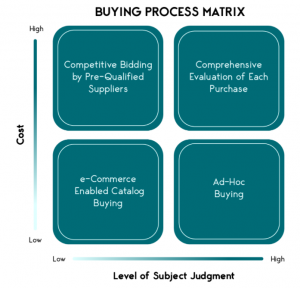 Procurement and marketing need to take hands and bring to an end the traditional stand-off between them, advises Texas-based supply chain veteran, Sarah Scudder. Building solid bridges begins with making decisions together.
Procurement and marketing need to take hands and bring to an end the traditional stand-off between them, advises Texas-based supply chain veteran, Sarah Scudder. Building solid bridges begins with making decisions together.
The relationship between marketing and procurement has often been strained since “marketing procurement” became a discrete business discipline more than two decades ago.
The good news is, the relationship is improving. In some companies, procurement and marketing professionals now work as a cohesive team. But recent research has shown that many companies have more work to do to build a productive marketing-procurement partnership.
In the 2019 Global Chief Procurement Officer Survey by Deloitte, only 15% of the respondents said sales and marketing leaders at their company would rate procurement as an excellent strategic partner, and 11% said the rating would be fair. More concerning, 52% of the respondents said their sales and marketing counterparts would give procurement a poor rating as a strategic business partner.
A 2018 survey of senior marketing procurement leaders by the World Federation of Advertisers produced similar results. In that study, 25% of the respondents said marketing’s view of marketing procurement was extremely positive, and another 62% said the view was somewhat positive. However, 92% of the respondents agreed that the way marketing procurement is viewed by their organisation could be improved.
Procurement experts have identified several steps that sourcing professionals can take to “win the hearts and minds” of their marketing colleagues. These include thoroughly understanding the objectives and needs of marketing, and focusing on value creation rather than on cost savings.
While these strategies are valuable, they don’t address the structure of the procurement-marketing relationship, and they don’t provide a framework for defining roles and responsibilities or for allocating decision-making authority. What procurement professionals and marketers need is an operating model for their relationship, and the most effective model is one that embodies shared decision-making.
Healthcare Provides the Model
Shared decision-making is increasingly prevalent in the practice of medicine. In the healthcare field, shared decision-making is a process in which clinicians and patients jointly make decisions based on clinical evidence that balances risks and expected outcomes with patient preferences and values.
Physicians have two primary responsibilities in a shared decision-making model – to provide the patient clear, evidence-based information about the potential risks and benefits of each treatment option, and to help the patient articulate his or her preferences and values relating to each potential treatment plan. The ultimate decision is made by the patient, but it results from a collaborative process.
Shared Decision-Making in Marketing Procurement
A shared decision-making model touches many aspects of the procurement-marketing relationship. With a shared decision-making approach, procurement and marketing professionals jointly define the buying processes that will be used to acquire the products and services required by marketing. In defining these processes, the key is to balance proven procurement best practices with the specific operational requirements of marketing.
As part of designing buying processes, procurement and marketing professionals must also jointly define their respective roles and responsibilities in those processes. By addressing this issue collaboratively – and in advance – a potential source of friction will be eliminated, and the buying processes will operate more smoothly.
Given the diversity of products and services used by marketing, procurement and marketing professionals will usually need to design more than one buying process. The attributes that make a buying process “right” for a given purchase are primarily determined by two factors – the cost of the product or service, and the level of subjective judgement involved in the purchase decision.
The following matrix illustrates that these two factors will usually indicate the need for four types of buying processes.

It’s also important to recognise that the roles and responsibilities of procurement and marketing will vary depending on the type of buying process involved. These differences become clear if we consider two of the buying processes shown in the matrix.
Comprehensive Evaluation
Purchases in the upper right quadrant of the matrix usually involve costly and complex products or services. Two classic examples would be large-scale agency services and some marketing technology applications. Because of the complexity, purchase decisions for these types of products or services will typically require a moderate to high level of subjective judgement.
Each purchase in this quadrant calls for a dedicated buying process that includes a comprehensive evaluation of the product or service. These purchases will usually be made by a buying group, and in a shared decision-making model, the buying group should include a procurement professional. In fact, a procurement professional can provide significant value by acting as the primary “facilitator” of the buying process.In this role, the procurement professional assists with research, coordinates meetings of the group, and manages interactions with prospective suppliers. The primary objective of the procurement professional in this type of buying process is to ensure that the buying group considers everything that’s relevant to the purchase decision.
Competitive Bidding
The purchases in the upper left quadrant of the matrix are also moderate to high-cost items, but these products and services are relatively easy to describe using detailed specifications. Therefore, the purchase decision usually involves only a low to moderate level of subjective judgement. Larger one-off print jobs are a good example of these types of purchases.
Purchases in this quadrant are usually made in a “buyer’s market.” Therefore, the best buying process to use for these purchases is one that emphasises competitive bidding among qualified suppliers.
In a shared decision-making model, procurement and marketing will jointly design the competitive bidding process and the business rules that will govern the process (who can purchase, maximum value of purchases, etc.). They will also jointly select and acquire the technology that will support the process. Once the “system” is operational, the execution of individual purchases can be delegated to appropriate procurement or marketing personnel.
A productive partnership between procurement and marketing is achievable in any company if the professionals in both functions approach the relationship with the right mindset. A shared decision-making model provides the necessary framework for building a successful partnership.
By Sarah Scudder, Manufacturing & Procurement Maven, Source Day



























